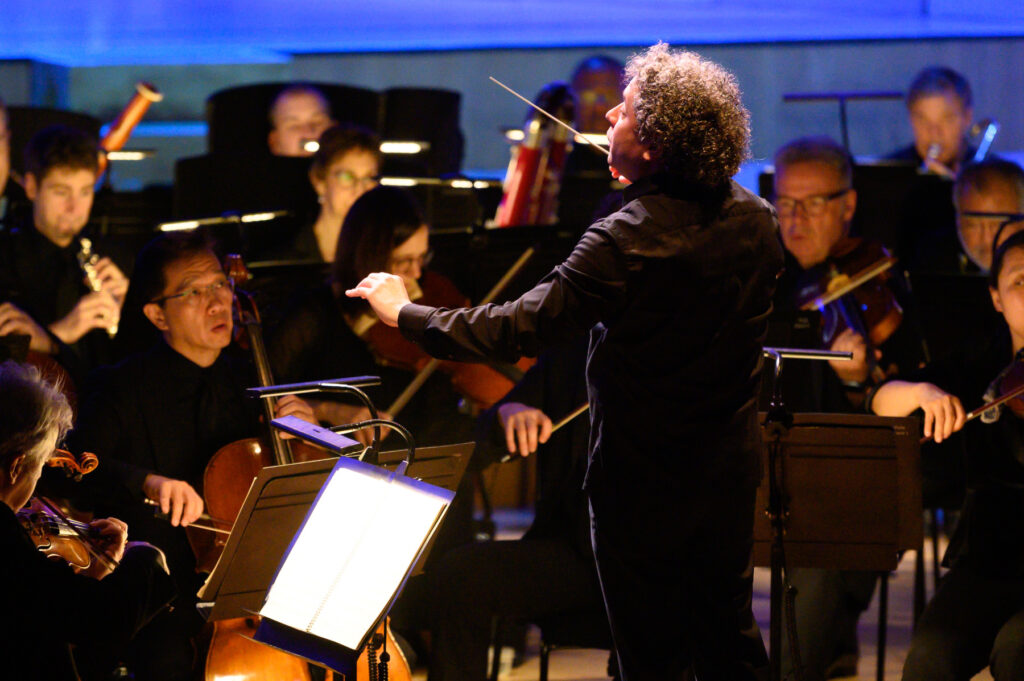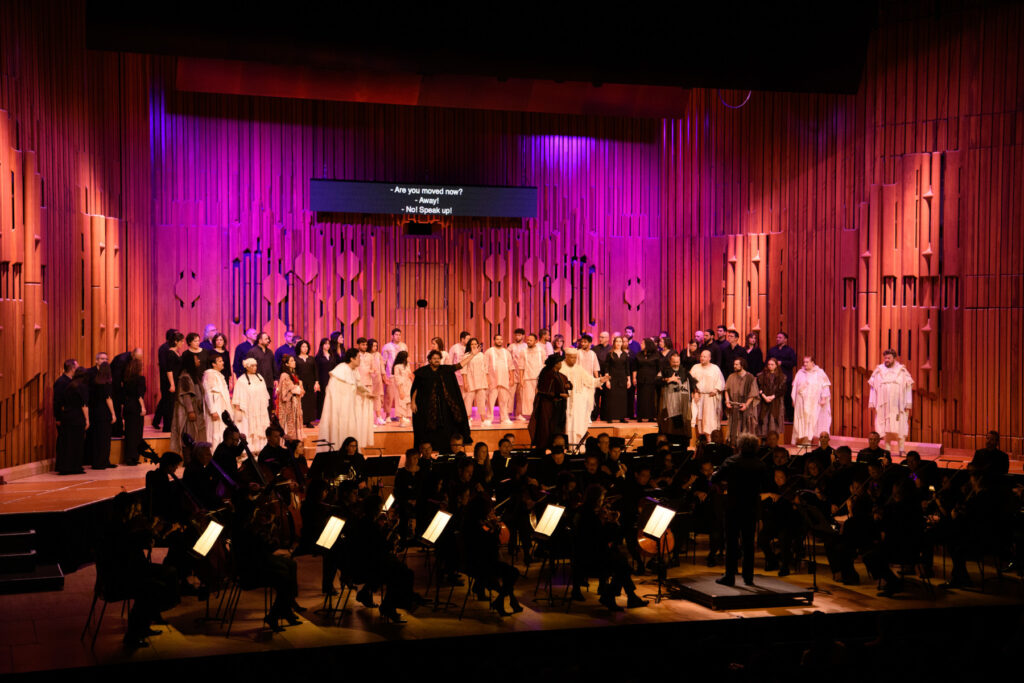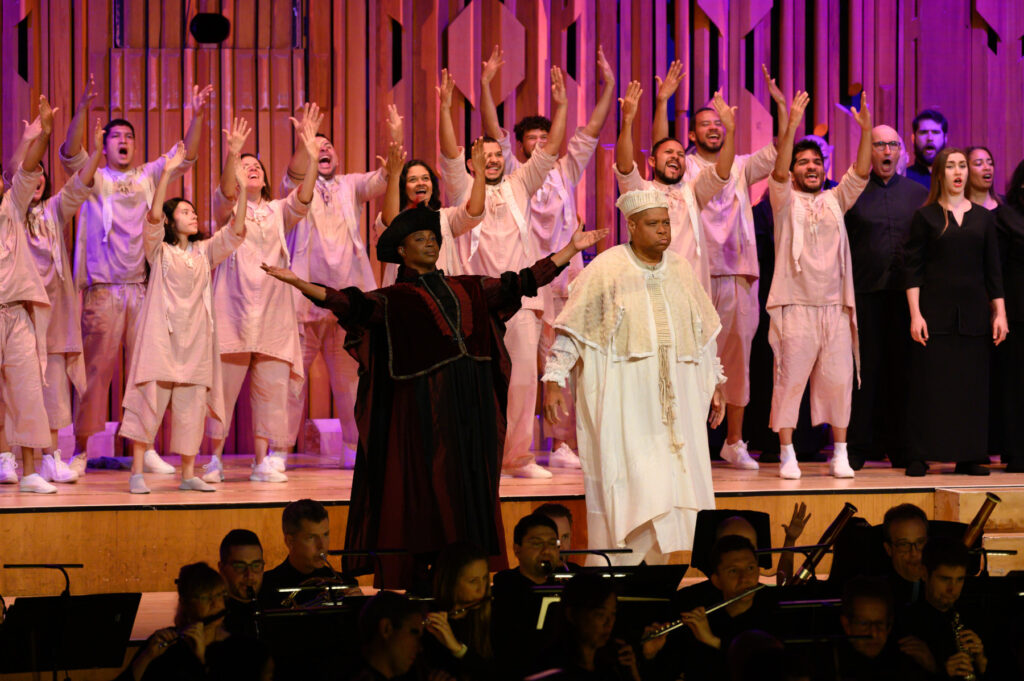After a traditionally-framed concert the night before – a John Williams ‘Overture’ (Olympic Fanfare), a ‘Concerto’ (Gabriela Ortiz’s Altar de cuerda) and Dvořäk’s symphony, ’From the New World’ – tradition took something of a running jump in this second one with the Los Angeles Philharmonic. A full opera, semi-staged using the full areas of the stage plus audience aisles, is nothing new. But here it was – Beethoven’s great hymn to brotherhood and peace, presented with both a signer, using International Sign, and a singer for each character. The two ‘versions’ of each character did occasionally interact, but by no means always. Singers were garbed in plain white; full costumes, colourful if not garish, and somewhat abstract, were saved for the silent actors.
Of course, for Fidelio, Singspiel(the almost comic opera opening), dialogue, and ‘Melodram’ – accompanied speech – lie at the work’s very core. We have all grown up with the classic Otto Klemperer recording, and Florestan’s spoken line ‘O mein Leonore, was has du für mich getan?” and Leonore’s response ‘Nichts, mein Florestan, nichts’ before the great duet ‘Namenlose Freude’. The contrast of speech to those soaringly upward lines is vital; but of that, obviously, there was none.
This has to be thought out, and deeply. So why did the Barbican booklet refer to ‘signed recitatives’? There are no recitatives in Fidelio (unless one counts those Artur Bodanzky composed for performances at the Met in the inter-war years). Anyway, director Alberto Arvelo sets out his stall nicely when he points out that ‘Fidelio represents a fight for freedom that is also a fight for inclusion and awareness. The work has been connected in a unique way with Deaf audiences since the premiere in November 1805, when the opera composer himself was already losing his hearing. Our Fidelio was conceived so that Deaf audiences could fully enjoy it for the first time in over two centuries.’

Lofty goals, then. The dual assignation of characters outlined above was indeed fascinating: a character ‘with two souls’ (Arvelo again) ‘who can express on a deeper level, the complexity of human nature’. The inflections of music were, in partnership with Deaf West Theatre, recreated via ‘the expressiveness of sign language and through visual expressions’.
Silence is a powerful tool – here, it becomes ‘one of the main characters in the opera’. The conception, then, is (pardon the pun) a sound one. But what of the realisation? The act of movement itself – not just signing – takes on huge significance in this context, and the whole was carefully choreographed, including stage placement of characters and, indeed, instruments. A rather nice touch was to have the solo trumpet fanfares in the second act (heralding the major dramatic change of direction) performed in the first instance off-stage, then for the second iteration, on-stage, to the side.
Lighting, too. contributed to the overall journey from darkness to light (two Tylers doing the honours: Tyler Glover and Tyler Lambert-Perkins). And then there were the small lights placed, artfully, around the stage – lights in the darkness of the political prisoners’ oppression, presumably.

In the event, all of these double roles did take some getting used to (surtitles helped, for sure) but his would be as nothing if the performance failed. Although Gustavo Dudamel seemed mismatched the previous evening in the only piece of core repertoire (the ‘New World’ Symphony), he felt much more at home here in Beethoven. Conducting without score, there were no superfluous slowings down here, and there was a finer conception of structure in tandem with his characteristic attention to detail. Conducting a far slimmer LAPO than the previous night, Dudamel found great transparency in Beethoven’s score. Special mentions should go to timpanist Joseph Pereiro (hard sticks, razor-sharp attack) and the four horns, who gave a truly superb rendition for the obbligato passages in Leonore’s aria, ‘Abscheilicher’. The same overall orchestral excellence was in evidence as the previous evening.
The singers were all of a high standard. A stand-out was Nicaraguan-American soprano Gabriella Reyes’ superb Marzelline. With skills honed at the Met (under the Lindemann Young Artists Development Programme), she revealed a pure soprano voice, and yet one of real power. The passages in the very final scene wherein Leonore and Marzelline trade phrases high up in their registers were of two absolute equal singers; her voice projected Marzelline’s hopes, her dreams, and her ‘O wär ich schon mit dir vereint’ a model of style, full of a young woman’s idealistic view of love and matrimony. A pity her Jaquino, David Portillo, was on the quiet side. The signed Marzelline, Sophia Morales, was as impressive as Reyes, living every gesture, absolutely full of energy and unbridled optimism; Otis Jones, as costumed/signing Jaquino, conveyed the young man’s aspirations superbly.
A Fidelio stands or falls by its Leonore and its Florestan, of course. Tamara Wilson’s sung Leonore was impressive vocally, but we have to hear the drama in the voice, regardless of whether it is being acted out around us or not. Her ‘Abscheulicher,’ from that perspective, did not raise to the dramatic heights of, say, a Lise Davidsen, or Sinéad Campbell-Wallace’s searing account for Insula Orchestra (both London and Paris performances were unforgettable). Wilson does have the requisite power for the role, though – small wonder she is taking on Isolde at the Deutsche Oper this summer. Her singer/actress was Amelia Hensley, brilliantly convincing in her conflicted emotions and yet of rock-solid resolution that justice be served. Andrew Staples’ repertoire is more focused at the other end of the operatic timeline, and as such he provided a lighter Florestan that certainly used to be the norm. The hairpin on his opening ‘Gott’ was convincing (the other reading is a soul-Schrei, as Jon Vickers showed in the classic HMV Klemperer set). Subtlety was the watchword of Staples’ first aria (‘Gott, welch’ dunkel hier’); it also meant a sweetly lyrical ‘In des Lebens Frühlingstagen’. But I did not hear the internalised pain and its periodic vocal externalisations which so characterised Stanislas de Barbeyrac’s Florestan for Insula.

James Rutherford’s Rocco was remarkable: a wonderful tone, great characterisation, a complete assumption of the role, one might argue, were it not for a slightly weaker lower register; his ‘Gold’ aria was a real highlight. Rocco’s silent Doppelgänger, Hector Reynoso, was a brilliant dramatic equivalent, his stage presence filling the Barbican (and possibly beyond) – great characterisation. If the Rutherford/Reynoso coupling was made in Heaven, the Shenyang/Maucere combo for Don Pizarro was made (in the nicest way possible) in Hell. The mononymous Shenyang’s dark voice was perfect for Pizarro’s black personality (‘Ha! Welch ein Augenblick!’), his partner in crime the signer Giovanni Maucere, hardly less menacing. Finally for the singers, Patrick Blackwell’s Don Fernando, a being of light (mirrored by Marvin Primeaux-O’Bryant’s dramatic rendition); in a twist of fate, Blackwell recently went over to the other side to sing Méphistophélès Faust for Valley Opera and performing Arts.
All credit, too, to the choruses (Coro de Manos Blancas, Cor de Cambra del Palau de la Música Catalana and the Cor dl Gran Teatre del Liceu). The Coro de Manos Blancas (White Hands Choir) was formed in 1995 to provide children, youth, and adults with disabilities with artistic opportunities (and they don’t get much bigger than this tour). The final scene was imposing; the Prisoner’s Chorus truly touching.
But, in the final analysis, did it work? For all the detail in the orchestra and the beauty of much of the singing, and the ambition of the conception, the combined effect was less, rather than more, overwhelming than many ‘straight’ performances, whether staged, semi-staged, or concert. The double-casting meant a lot was going on at any one given time, and everything needs to continually illuminate Beethoven’s processes. Mostly it did, but sometimes the split of attention required was distracting.
A once in a lifetime experience, though, for sure, and one I would not have been without.
Colin Clarke
Fidelio
Music composed by Ludwig van Beethoven.
Libretto by Joseph Sonnleithner, revised Stephan von Breuning and Georg Friedrich Treitschke
Cast and production staff:
Fidelio/Leonore– Tamara Wilson (soprano)/Amelia Hensley (actor); Florestan – Andrew Staples (tenor)/Daniel Durant (actor); Rocco – James Rutherford (bass-baritone)/Hector Reynoso (actor); Marzelline – Gabriella Reyes (soprano)/Sophia Morales (actor); Jaquino – David Portillo (tenor)/Otis Jones (actor); Don Pizarro – Shenyang (bass-baritone/Giovanni Maucere (actor)); Don Fernando – Patrick Blackwell (bass-baritone)/Marvin Primeaux-O’Bryant (actor)
Director – Alberto Arvelo; Co-Director – Joaquín Solano, Artistic Producer – Gabriela Comejo; Costumes – Solange Mendoza; Lighting – Tyler Glover, Tyler Lambert-Perkins; Sign Language Choreographer – Colin Analco; Assistant Sign Language Choreographer – Bridget Berrigan; Deaf West Theatre; Coro de Manos Blancas; Cor de Cambra del Palau de la Música Catalana; Cor del Fran Theatre del Liceu; Los Angeles Philharmonic Orchestra, Conductor – Gustavo Dudamel
Barbican Hall, London, 3 June 2024